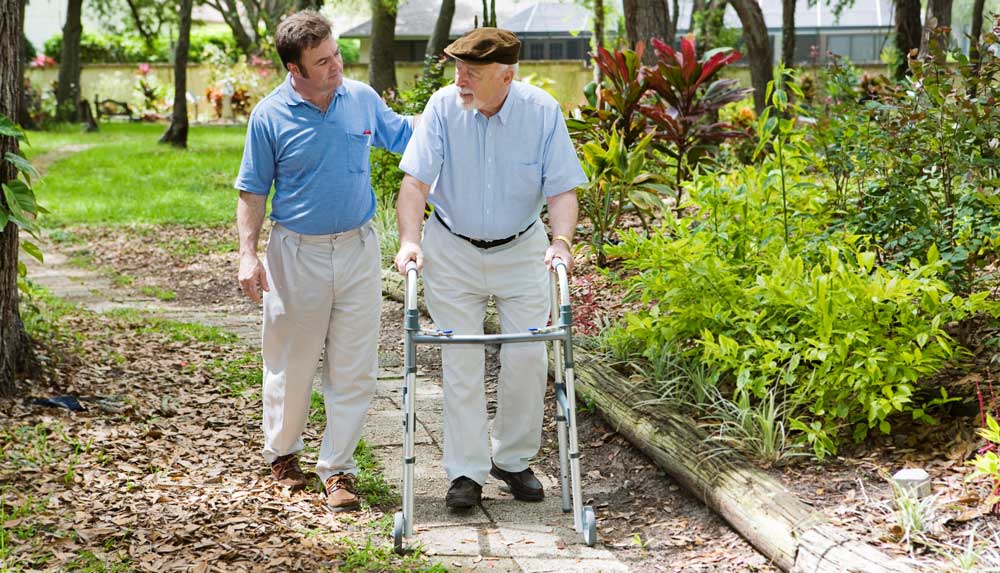
Slips and falls for seniors are no laughing matter. As we or our loved ones get older, living in the homes that we’ve known for years can suddenly become challenging as a few steps to the front door, a sloping sidewalk, or a slippery deck become everyday challenges. This article will guide you through the preventative measures you can take to help make the outside of a home senior safe and friendly!
Even though it is an inevitable process, many of us fear aging for ourselves and our loved ones. As we get older we find that we are not able to move as we once did. Our steps become less steady and our ability to balance deteriorates. Living in the homes that we’ve known for years can suddenly become challenging as a few steps to the front door, a sloping sidewalk or a slippery deck become everyday challenges. This article will guide you through the preventative measures you can take to help make the outside of a home senior safe and friendly!
Slips and Falls for Seniors are No Laughing Matter
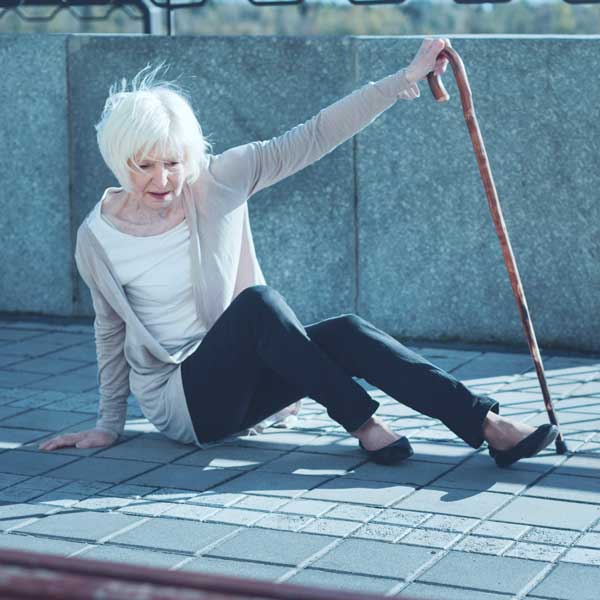
The National Association of Home Builders (NAHB) published a remodeling checklist to help create a safe and seamless aging-in-place experience. The checklist outlines various renovations that should be done in order to make the home safe and accessible for seniors. Below, you will find our suggestions to make the exterior of your home safe and accessible for a seamless aging-in-place transition.
Making the Exterior of a House Senior Stay-at-Home Safe
Do you know the one thing that the exterior of every home shares in common? Changing weather! OK, we admit that in desert climates the weather doesn’t change all that much, but over 95% of us live in areas where precipitation in one form or another is a fairly common occurrence. Precipitation, whether in the form of rain or snow, can make normally safe outdoor structures like steps, patios, and walkways slip, trip, and fall hazards.
Here are just a few of the environmental conditions that can conspire with simple outdoor structures to make living at home dangerous for seniors:
- Rain and dew
- Ice and snow
- Mold and mildew
- Fallen leaves, mud, or other landscaping debris
- Degradation of building materials (like chipping steps)
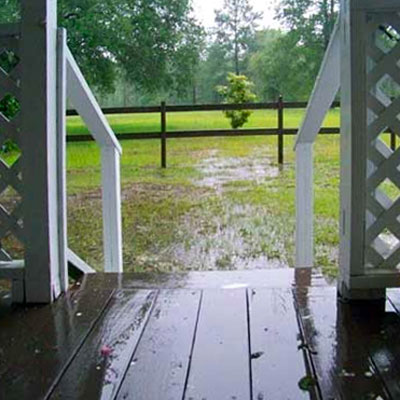
This doesn’t mean that each drop of rain or flake of snow is a disaster waiting to happen, it just means some preventative steps can and should be taken to mitigate the risk of falling as we get older. Indeed, there are a number of great solutions that can be put in place to prevent slips and falls on these outdoor structures. Let’s tackle a few of the most common outdoor structures and discuss the pros and cons of potential solutions.
Outdoor Stairs
Most homes have steps leading up to the porch or deck, even if it is just one. The environmental conditions listed above can make outdoor steps incredibly dangerous to walk on, especially for seniors. These stairs can also become slip and fall hazards as they deteriorate with age. For example, wood steps may start to bow or split, and concrete steps can start to chip and crack.
In order to prevent slip and fall injuries on outdoor stairs, the installation of non-slip solutions is key. These solutions vary in composition and application and come with their own advantages and disadvantages.
Grit Treads or Tape
Grit treads and tape can be found at virtually any hardware or home improvement store. Because they are widely available, they are most often the first place homeowners turn when seeking to give their outdoor stairs more traction. While they provide great traction in dry conditions, their effectiveness sharply decreases in sleet, ice, or snow.
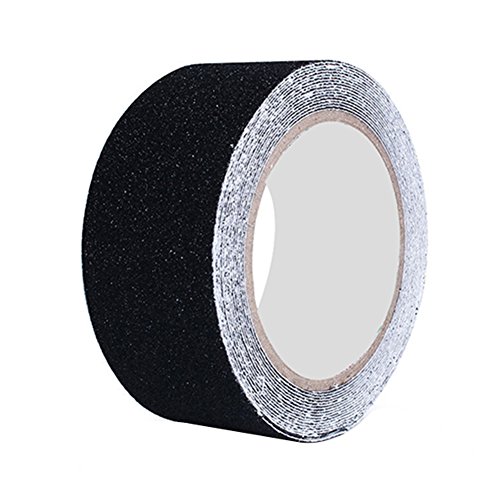
Advantages
- Easy to apply
- Some are available in photoluminescent shades for extra safety
- Inexpensive and widely available
Disadvantages
- Not suitable for use in ice or snow
- Peels within a year
- Not permanent, and need to be replaced every 1-2 years
Aluminum Stair Treads
Unlike other solutions, aluminum treads are a permanent non-slip solution. Once they are installed, they do not have to be replaced and there is no required maintenance. The treads are installed with screws and can be applied to almost any surface like wood, concrete, or stone. The patented raised-button surface of the treads provides traction in any environmental condition.
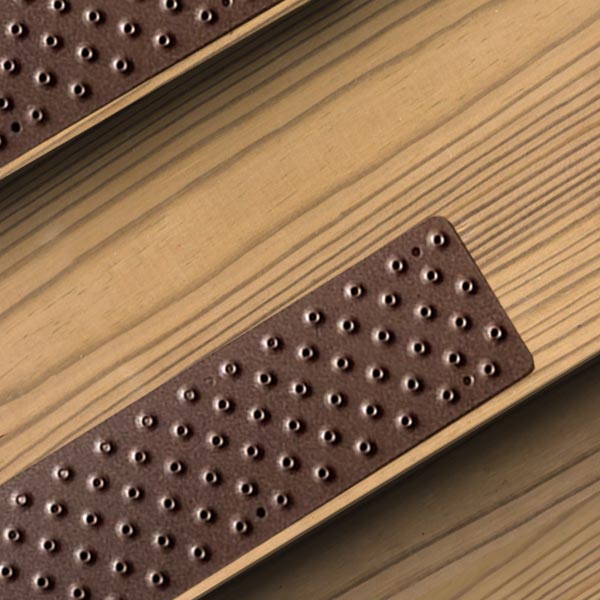
Advantages
- Can be installed on virtually any surface
- Permanent with a lifetime warranty
- Provides traction in rain, sleet, and up to an inch of snow or debris
Disadvantages
- More expensive initial investment
- Need a power drill for installation
Aluminum Stair Nosings
Like aluminum stair treads, aluminum stair nosings are a permanent non-slip solution. They cover the nosing of the stair tread, which is the edge of the stair tread that juts out. The raised button surface of the nosings provides traction in all weather conditions while also supporting steps that are cracking or splitting.
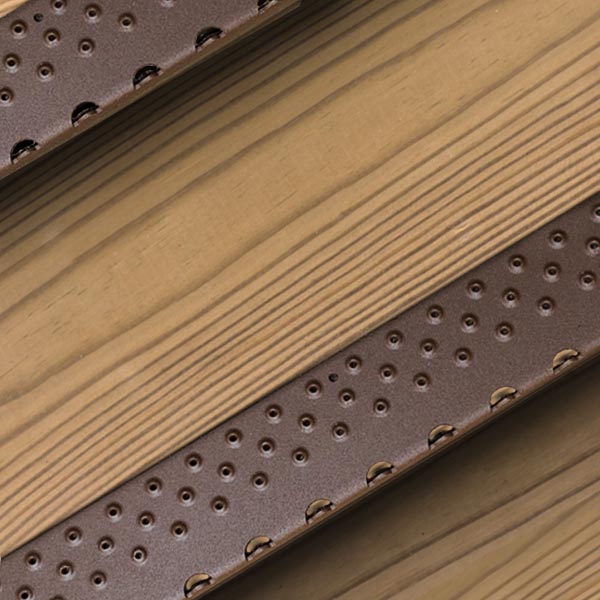
Advantages
- Permanent with a lifetime warranty
- Adds structural integrity to steps that are deteriorating
- Provides traction in rain, ice, and snow
Disadvantages
- More expensive initial investment
- Need a power drill for installation
Porches and Decks
Like outdoor stairs, porches and decks can become incredibly slippery throughout the year. It is important to implement fall prevention solutions in these areas not only for physical safety but for emotional well-being. Seniors can begin to feel limited in what they can do, so it is important that all areas of the home are accessible. Being able to safely walk on the deck or porch to enjoy the sunshine creates a more comfortable environment for aging-in-place.
There are multiple solutions that can be used to create a safe and inviting porch or deck area. Again, since these solutions vary in their composition and application, they each present their own unique advantages and disadvantages.
Deck Strips
Deck strips are 48″ by 1″ aluminum strips that have an electrically bonded colored epoxy tint with an embedded polyester grit that creates a non-slip texture that feels like 80 grit sandpaper. The non-slip deck strips provide instant traction yet remain comfortable to walk on with bare feet.
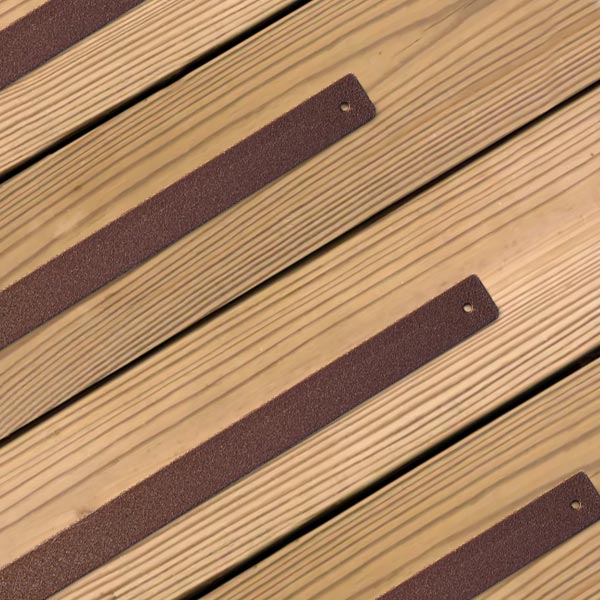
Advantages and Disadvantages
- The shade range is ideal for popular deck colors
- Intended to cover large areas
Disadvantages
- Not intended to provide traction in snow or ice
- Have a warranty, but only for one year
Deck Treads
Like deck strips, deck treads are constructed specifically for use with decks or porches. They are constructed of aluminum and have a patented raised-button surface that creates superior traction in all weather conditions.
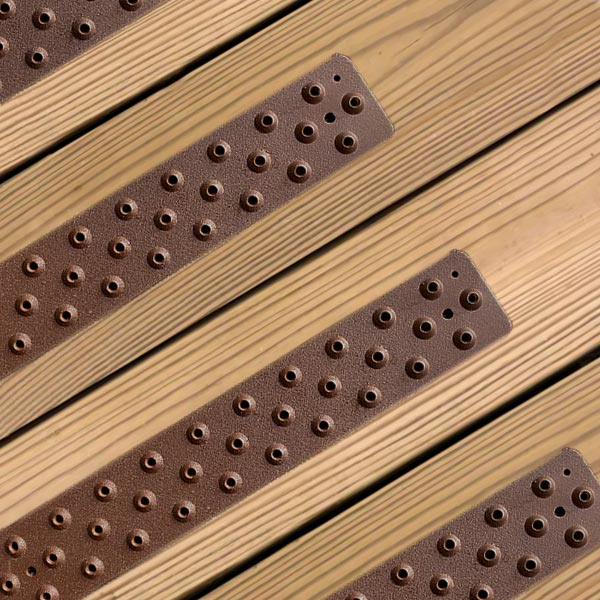
Advantages
- Permanent solution with a lifetime warranty
- Intended to cover large areas
- Ideal for year-round use in all weather conditions
Disadvantages
- Can be more expensive than other non-slip solutions
Non-Slip Paint and Coatings
Non-slip paint or similar treatments create traction on a porch or deck with an aggregate in the paint. Since the paint covers the entire surface, there is slip and fall protection from all directions. However, if the paint is covered by ice, snow, or debris, the paint’s effectiveness drastically decreases.
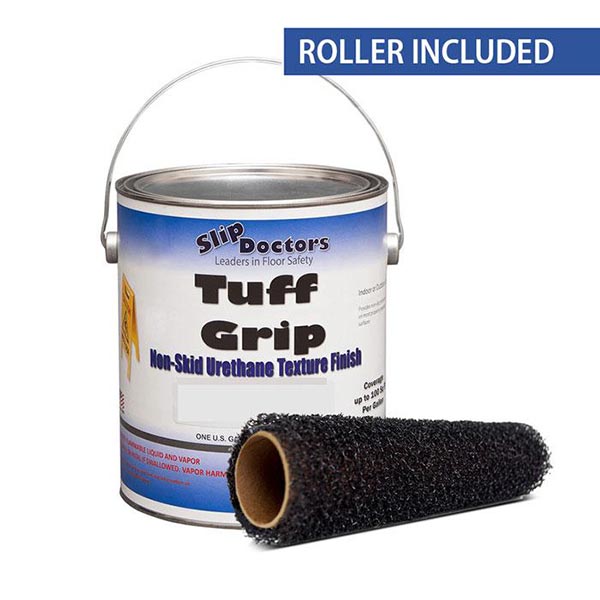
Advantages
- Can be applied to almost any surface
- Available in numerous shades
- Benefits the entire surface
Disadvantages
- Can be very expensive
- Needs to be reapplied every 2-3 years
- Not fit for heavy snow or ice
Walkways
Like the outdoor structure above, walkways must also be able to withstand all four seasons. Depending upon your location, winter may bring snow and ice that can cover your walkways, making them incredibly slippery and dangerous. Even without winter weather, walkways can become slippery due to rain or mold and mildew caused by moisture.
While there are not as many solutions specifically designed to make outdoor home walkways non-slip, there are still actions you or your loved ones can take to prevent slips, trips, and falls.
Landscaping
Many homeowners take pride in their yards and landscaping. Successful aging-in-place doesn’t mean that you have to completely give up on creating an inviting outdoor oasis. However, aspects of your landscaping may interfere with the outdoor walkways at your home, creating clip and fall hazards.
Be sure to trim any branches from trees or bushes that are creeping over or onto the pathway. This always goes for any moss that may be growing in between brick or stone walkways. As the moss grows, it can form a raised mound that is easily tripped over.
While seniors may pass on landscaping duties to lawn services, it is important to ensure that any landscaping debris such as raked leaves or moved grass is properly disposed of. A pile of leaves or grass clippings can easily cause a trip, especially when the ground is wet.
Maintenance
It is also important to keep up with the necessary maintenance of your home’s outdoor walkways. With most walkways being constructed of either concrete, stone, or brick, there are steps you can take to ensure that these materials do not create any hazards when walking.
Concrete pathways can begin to crack. Depending on the size and the fragments displaced, the crank can cause you or a loved one to slip and fall. These cracks can easily be fixed by purchasing premixed concrete patches. Simply take some of the premixed concrete and use a flat steel trowel to smooth the mix over the crack. If any of the bricks or stones in your walkways begin to chip or crack, make sure to replace them with a new one.
As the seasons and weather change, measures must be taken to ensure clear passage on outdoor walkways. When snow starts to collect on walkways, it is imperative to shovel it away as soon as possible. Not only is fallen snow slippery on its own, but if left for prolonged periods of time it can become compacted and icy which is even more dangerous. It is also important to salt any walkways during the winter to increase traction when walking and help prevent ice from forming.
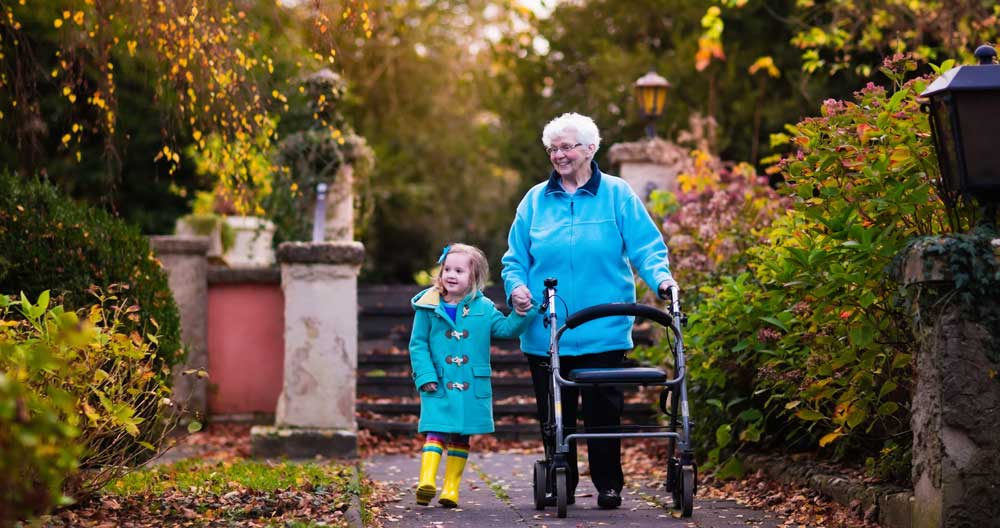
Successful Aging-in-Place
While it may seem like there is an overwhelming amount of renovations and maintenance that should be done for successful aging-in-place, the key ingredient is education. Simply being aware of the dangers of slips, trips, and falls in the home will help you create a safer place to age for you or your loved ones. The next step, taking action by installing non-slip solutions and maintaining the home, will give you peace of mind.
